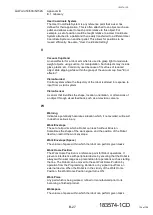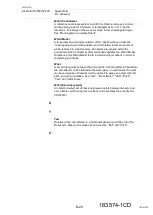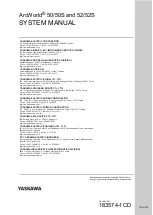
B-16
183574-1CD
183574-1CD
Appendix B
B.1 Glossary
ArcWorld 50/50S/52/52S
Operator
The person designated to start, monitor and stop the intended productive
operation of a robot or robot system. An operator may also interface with a
robot for productive purposes. (R15.06)
Optical Encoder
A detection sensor, which measures linear or rotary motion by detecting
the movement of markings past a fixed beam of light. This can be used to
count revolutions, identify parts, etc.
Optical Proximity Sensors
Robot sensors which measure visible or invisible light reflected from an
object to determine distance. Lasers are used for greater accuracy.
Orientation
The angle formed by the major axis of an object relative to a reference
axis. It must be defined relative to a three dimensional coordinate system.
Angular position of an object with respect to the robot's reference system.
See
,
and
P
Palletizing
The process of stacking packages (i.e., boxes, bags, containers, etc.) in
an organized fashion on a pallet.
PAM Function – Position Adjustment by Manual
Position Adjustment by Manual allows position adjustment by simple
operations while observing the motion of the Robot, and without stopping
the Robot. Positions can be adjusted in both TEACH mode and PLAY
mode.
Parallel Shift Function
parallel shift function Parallel Shift refers to the shifting of an object from a
fixed position in such a way that all points within the object move an equal
distance. In the model for Parallel Shift shown in the following, the shift
value can be defined as the distance L (three dimensional coordinate
displacement). The Parallel Shift Function is relevant to the actual
operation of the Robot because it can be used to reduce the amount of
work involved in teaching by shifting a taught path (or position). In the
example in the figure below, the taught position A is shifted in increments
of the distance L (this is actually a three dimensional XYZ displacement
that can be recognized by the robot).
Path
The continuous locus of positions (or points in three dimensional space)
traversed by the tool center point and described in a specified coordinate
system. (R15.05-2)
Payload - Maximum
The maximum mass that the robot can manipulate at a specified speed,
acceleration/deceleration, center of gravity location (offset), and
repeatability under continuous operation over a specified working space.
Maximum payload is specified in kilograms. (R15.05-2)
Pendant
See
113 of 126














































